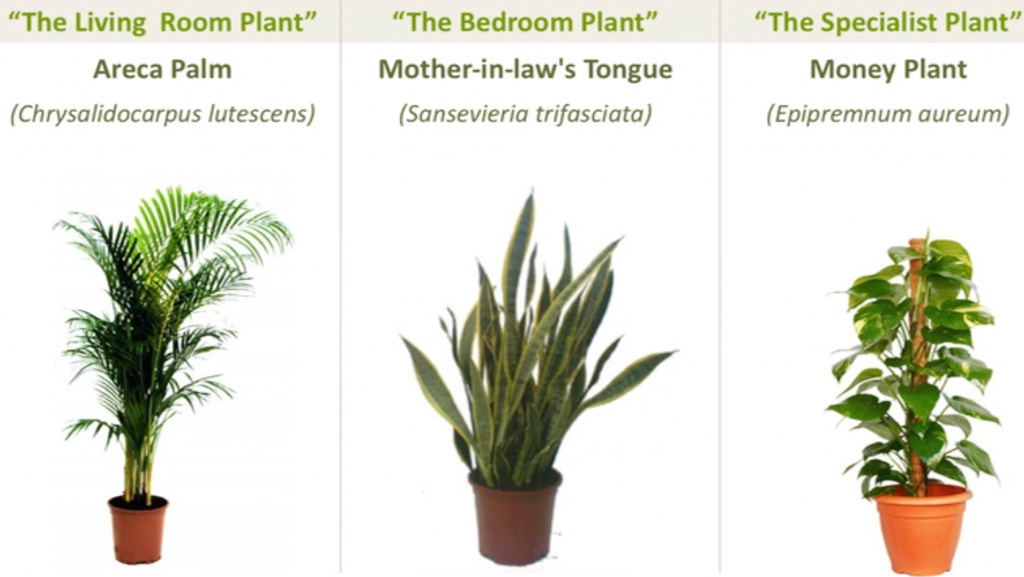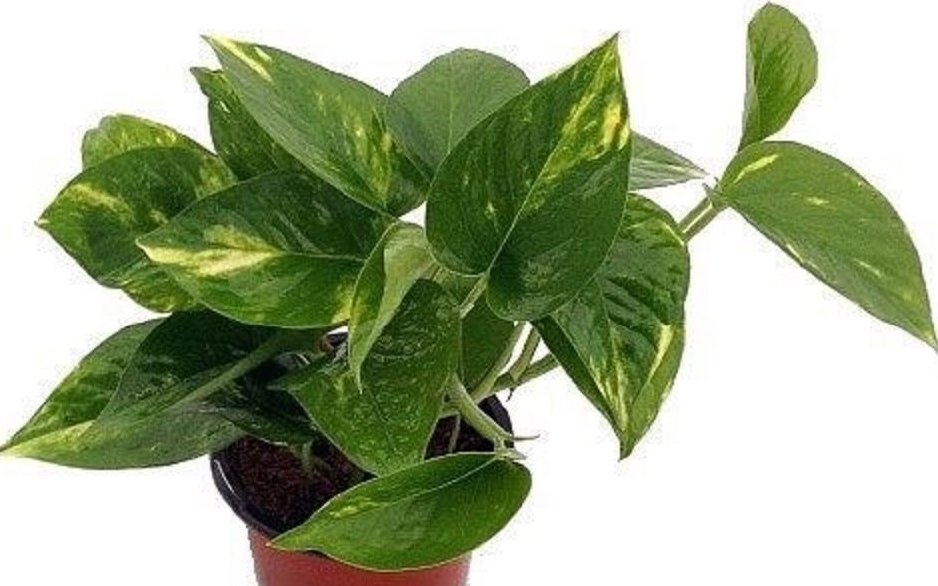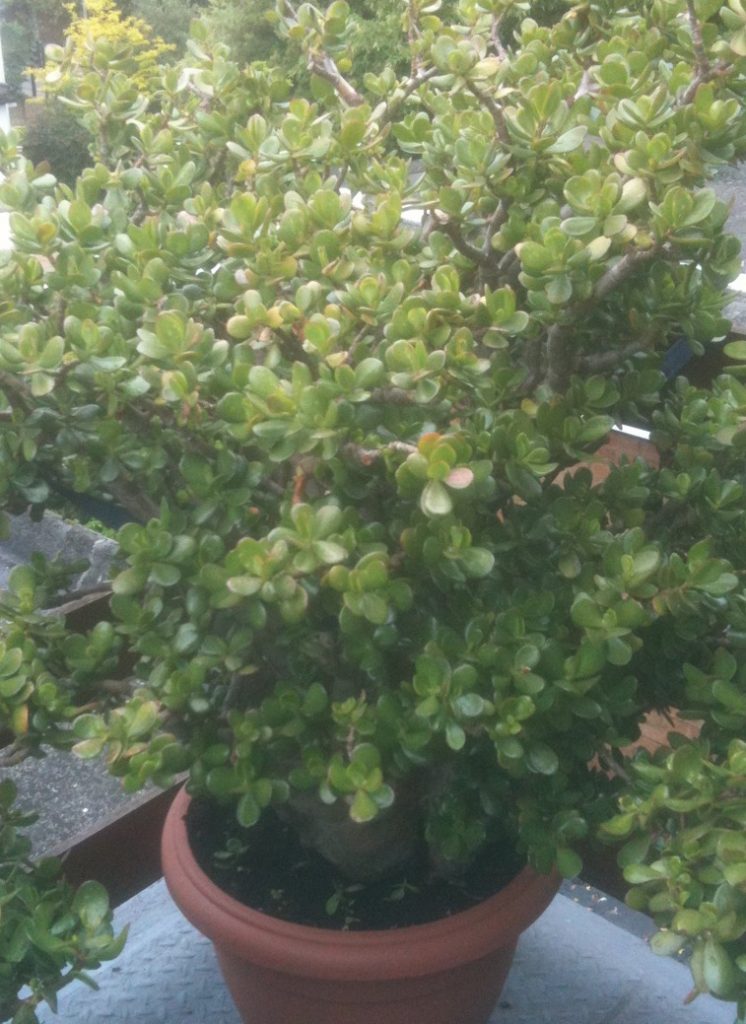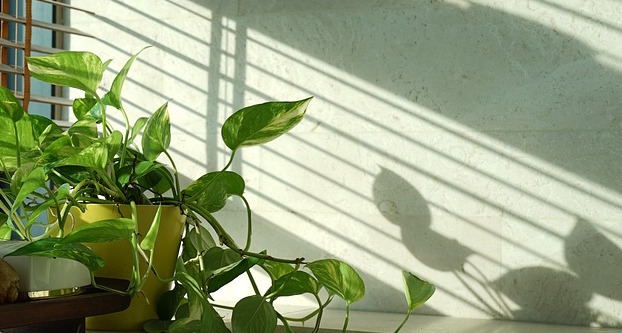
Top air cleansing plants: areca palm, mother-in-law’s tongue and an Indian money plant (Epipremnum aureus)
Experts suggest that the air inside our homes and workplaces can be more polluted than outside by air fresheners, bathroom cleaners and bleach and so on. The first step: open your windows. Next step: get some air cleansing plants.
Read How To Grow Fresh Air: 50 Houseplants that Purify Your Home or Office by Dr B. C. Wolverton who is a scientist who worked for NASA researching a breathable environment for a lunar habitat. He discovered that houseplants are the best filters of common pollutants where the foliage and roots work together to absorb chemical pollutants from the air. Read the original study: A study of interior landscape plants for indoor air pollution abatement by NASA, 1989
Research on plants: boost productivity
Research suggests that just a few plants have a strong effect on productivity in the workplace. Dr Craig Knight (from the University of Exeter, who studied the psychology of working environments for 12 years) studied how employees performed in a different environment and said, “The improvement in productivity from placing plants near to staff was remarkable.” The next logical step would be to test what kind of plants made the difference. ( “The Relative Merits of Lean, Enriched, and Empowered Offices: An Experimental Examination of the Impact of Workspace Management Strategies on Well-Being and Productivity by Craig Knight and S. Alexander Hallam, University of Exeter”)
‘There is a fashion for minimalist, monochrome styling which pleases managers, but in reality it crushes the human spirit. Adding plants makes people happier and productive – but the real benefit comes from giving them autonomy.” Psychologist Dr Craig Knight
Feng shui plants boost chi/energy in your home and workplace
• Money plants (Crassula ovate also commonly known as jade plant, friendship tree, lucky plant, or money tree) – place them in your wealth corner/s or in the south-facing part of the house (they like the sun).
Please note that there are two types of feng shui money plants:
1) Crassula ovate which is more popular with the Chinese population and
2) Epipremnum aureum (see above on the right) which is more popular with the Indian population. Both plants are perceived as money and prosperity attracting plants.
• Ferns – place them everywhere to ionise the air.
• Plants are one of the top feng shui interventions to uplift the energy of any environment, for homes and workplaces. For example, if you live in a basement, the upward moving energy will balance the downward moving energy of the basement.
• Plants belong to the wood or tree element in the five elements model (which is a cornerstone of Chinese philosophy, medicine and feng shui). Plants represent growth and expansion. So if you want to boost your profits or expand your business or improve your health, plants should be one of the first feng shui remedies to use.
• Research suggests that the presence of plants in offices boost productivity and creativity.
• Plants help to reduce stress.
• Plants induce a good mood.
• Plants promote creativity: 15% boost in a number of creative ideas (by males) and more original solutions (by females).
• Plants belong to the tree/wood element which is associated with wealth creation.
“Air plants are booming in popularity due to the fact that they are so versatile nd easy to grow.”
Guy Barter, the chief horticulturist at the Royal Horticultural Society (RHS)
Biophilia
According to Wikipedia: “The biophilia hypothesis suggests that there is an instinctive bond between human beings and other living systems. Edward O. Wilson introduced and popularized the hypothesis in his book, Biophilia (1984). He defines biophilia as “the urge to affiliate with other forms of life”. In short, biophilia is about a positive and beneficial contact with nature. There is lots of research suggesting that regular contact with nature is highly beneficial for humans on many levels, from physical to emotional to mental and even spiritual. Short of living in the countryside, these easy to grow houseplants offer an immediate boost to your biophilia effect.
Power plants for healing
Recent research suggests that people work better and recover quicker in hospitals where there are plants. NASA ran a study assessing how plants process carcinogens found in indoor air. Plants can reduce dust levels up to 40%.
Views & pictures of nature
• trigger endorphin effect
• lower blood pressure
• boost the brain’s attention
• accelerate patients’ recovery
• reconnect with nature
The top best air purifying plants are:
Spider plant
Peace Lily
The Feston Rose plant
Devil’s Ivy
Phalaenopsis
English Ivy
Parlor Ivy
African Violets
Christmas Cactus
Yellow Goddess
Bamboo palm
Areca palm
Golden pathos
Chrysanthemum
Garlic Vine
Fern (Boston fern) – also produces negative ions – urban homes and offices usually have high levels of positive ions which can make you feel lethargic
Mother-in-law’s tongue – good for bedrooms because it converts CO2 into oxygen. Some feng shui enthusiasts might object to this spiky plant (feng shui doesn’t like sharp corners and spiky objects) but pointy objects represent fire element (in the five-element theory) and a bit of ‘fire’ or passion in your bedroom can do magic for some aspects of your life as well as boost focus and clarity (which are key characteristics of the fire element) – as long as the spiky plant is not too close to where you’re sitting or sleeping.
How many plants do we need in one home?
A rule of thumb is to have three to five medium-size plants per person.
The World’s First Living and Breathing (and Air Purifying) Chandelier
The full list of 50 air cleansing plants listed in How to Grow Fresh Air: 50 Houseplants that Purify your Home or Office:
1 Areca Palm (Chrysalidocarpus lutescens)
2 Lady Palm (Rhapis excelsa)
3 Bamboo Palm (Chamaedorea seifrizii)
4 Rubber Plant (Ficus robusta)
5 Deacaena “Janet Craig” (Dracaena dermensis)
6 English Ivy (Hedera helix)
7 Dwarf Date Palm (Phoenix roebelenii)
8 Ficus “Alii” (Ficus macleilandii)
9 Boston Fern (Nephrolepis exaltata “Bostoniensis”)

Boston Fern
10 Peace Lily (Spathiphyllum)
11 Corn Plant (Dracaena fragrans)
12 Golden Pothos (Epipremnum aureum)
13 Kimberley Queen Fern (Nephrolepis obliterata)
14 Pot Mum (Chrysanthemum morifolium)
15 Gerbera Daisy (Gerbera jamesonii)
16 Dracaena “Warneckei” (Dracaena dermensis)
17 Dragon Tree (Dracaena marginata)
18 Red Emerald Philodendron (Philodendron erubescens)
19 Syngonium (Syngonium podophyllum)
20 Dumb Cane (Dieffenbachia “Exotica Compacta”)
21 Parlor Palm (Chamaedorea elegans)
22 Weeping Fig (Ficus benjamina)
23 Schefflera / Umbrella Plant (Schefflera arboricola)
24 Wax Begonia (Begonia Semperflorens)
25 Lacy Tree Philodendron (Philodendron selloum)
26 Heart-Leaf Philodendron (Philodendron Oxycardium)
27 Snake plant / Mother-in-Law’s Tongue (Sansevieria trifasciata / laurentii
28 Dumb Cane (Dieffenbachia camilla)
29 Elephant Ear Philodendron (Philodendron domesticum / tuxla)
30 Norfolk Island Pine (Araucaria heterophylla)
31 King of Hearts (Homalomena wallisii)
32 Prayer Plant (Maranta leuconeura “Kerchoveann”)
33 Dwarf Banana (Musa cavendishii)
34 Christmas Cactus (Schlumbergera buckleyi)
35 Easter Cactus (Schlumbergera gaertneri)
36 Oakleaf Ivy (Cissus rhombifolia “Ellen Danika”)
37 Lily Turk (Liriope spicata)
38 Dendrobium Orchid (Dendrobium)
39 Spider Plant (Chlorophytum comosum)
40 Chinese Evergreen (Aglaonema crispum “Silver Queen”)

Golden Pothos
41 Anthurium (Anthurium andraeanum)
42 Croton (Codiaeum variegatum pictum)
43 Poinsettia (Euphorbia pulcherrima)
44 Dwarf Azalea (Rhodedendron simsii “Compacta”)
45 Peacock Plant (Calthea makoyana)
46 Aloe Vera (Aloe barbadensis)
47 Cyclamen (Cyclamen persicum)
48 Urn Plant (Aechmea fasciata)
49 Moth Orchid (Phalaenopsis)
50 Kalanchoe (Kalanchoe blossfeldiana)
Air plants – no soil, no water
Don’t have green fingers? Don’t have time to look after plants or you don’t have enough space for plants? Air plants don’t require soil, nor water to grow and take up very little space. They require minimum attention and can fit into small places. They only need occasional misting and sunlight. So, no excuses any more, not to benefit from the micro-biophilia effect.
“Air plants are compact, exotic and stylish, making them a great addition to rooms of any size.”
Guy Barter, the chief horticulturist at the Royal Horticultural Society (RHS)

Air plants to boost feng shui in your home and workplace
Popular variety of air plants
• Spanish moss, tillandsia usneoides, produces small, fragrant yellow flowers
• Tillandsia xerographica, with colour changing leaves that go from sliver green to bluish-pink in bright light
For ideas try Terrarium workshops and Patch Plants
Top tips for caring for your air plants
• During winter, air plants need warmth, air and light but during summer they can stay outside.
• Some air plants need to be placed out of direct sunlight or behind the net curtain.
• Most air plants don’t need watering – occasional misting – they’re very good at keeping moisture.
• Air plants can be hung from almost anything such as w wire, or attached to anything such as driftwood, rocks or seashells.



